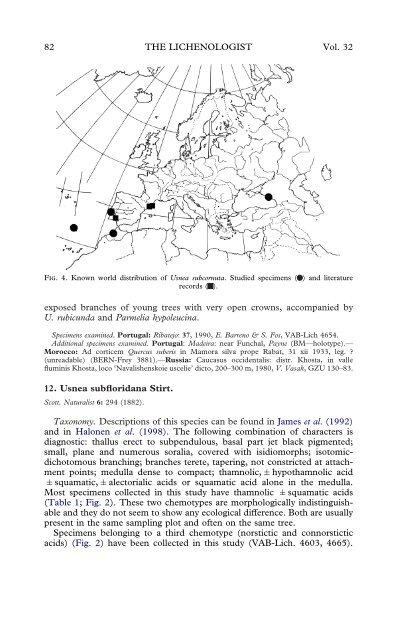the lichen genus usnea on quercus suber in iberian cork-oak forests
the lichen genus usnea on quercus suber in iberian cork-oak forests
the lichen genus usnea on quercus suber in iberian cork-oak forests
Create successful ePaper yourself
Turn your PDF publications into a flip-book with our unique Google optimized e-Paper software.
82 THE LICHENOLOGIST Vol. 32<br />
Fig. 4. Known world distributi<strong>on</strong> of Usnea subcornuta. Studied specimens ( ) and literature<br />
records ( ).<br />
exposed branches of young trees with very open crowns, accompanied by<br />
U. rubicunda and Parmelia hypoleuc<strong>in</strong>a.<br />
Specimens exam<strong>in</strong>ed. Portugal: Ribatejo: 37, 1990, E. Barreno & S. Fos, VAB-Lich 4654.<br />
Additi<strong>on</strong>al specimens exam<strong>in</strong>ed. Portugal: Madeira: near Funchal, Payne (BM—holotype).—<br />
Morocco: Ad corticem Quercus <strong>suber</strong>is <strong>in</strong> Mamora silva prope Rabat, 31 xii 1933, leg. ?<br />
(unreadable) (BERN-Frey 3881).—Russia: Caucasus occidentalis: distr. Khosta, <strong>in</strong> valle<br />
flum<strong>in</strong>is Khosta, loco ‘Navalishenskoie uscelie’ dicto, 200–300 m, 1980, V. Vasak, GZU 130–83.<br />
12. Usnea subfloridana Stirt.<br />
Scott. Naturalist 6: 294 (1882).<br />
Tax<strong>on</strong>omy. Descripti<strong>on</strong>s of this species can be found <strong>in</strong> James et al. (1992)<br />
and <strong>in</strong> Hal<strong>on</strong>en et al. (1998). The follow<strong>in</strong>g comb<strong>in</strong>ati<strong>on</strong> of characters is<br />
diagnostic: thallus erect to subpendulous, basal part jet black pigmented;<br />
small, plane and numerous soralia, covered with isidiomorphs; isotomicdichotomous<br />
branch<strong>in</strong>g; branches terete, taper<strong>in</strong>g, not c<strong>on</strong>stricted at attachment<br />
po<strong>in</strong>ts; medulla dense to compact; thamnolic,hypothamnolic acid<br />
squamatic,alectorialic acids or squamatic acid al<strong>on</strong>e <strong>in</strong> <str<strong>on</strong>g>the</str<strong>on</strong>g> medulla.<br />
Most specimens collected <strong>in</strong> this study have thamnolic squamatic acids<br />
(Table 1; Fig. 2). These two chemotypes are morphologically <strong>in</strong>dist<strong>in</strong>guishable<br />
and <str<strong>on</strong>g>the</str<strong>on</strong>g>y do not seem to show any ecological difference. Both are usually<br />
present <strong>in</strong> <str<strong>on</strong>g>the</str<strong>on</strong>g> same sampl<strong>in</strong>g plot and often <strong>on</strong> <str<strong>on</strong>g>the</str<strong>on</strong>g> same tree.<br />
Specimens bel<strong>on</strong>g<strong>in</strong>g to a third chemotype (norstictic and c<strong>on</strong>norstictic<br />
acids) (Fig. 2) have been collected <strong>in</strong> this study (VAB-Lich. 4603, 4665).

















